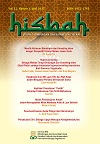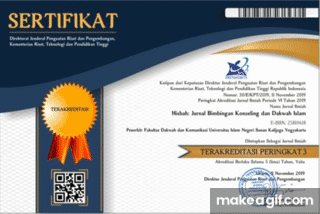EFEKTIVITAS LOGOTERAPI DALAM MENINGKATKAN KEBERMAKNAAN HIDUP PADA NARAPIDANA
DOI:
https://doi.org/10.14421/hisbah.2022.191-07Abstract
This study aims to see the effectiveness of logotherapy in increasing the meaning of life in prisoners. People who commit crimes are people who have lost their meaning, they feel a false existential. Being in prison is an unpleasant experience, but when painful things cannot be interpreted, a person will not find his true self. In this study using the experimental method with a one group pretest posttest design. Logotherapy was given to 6 prisoners who were selected based on certain criteria. The intervention lasted 90-120 minutes per session, totaling 6 sessions. This study uses a non-parametric statistical analysis test with Wilcoxon sign-rank. The results of the significance scale scores were analyzed using the Wilcoxon sign-rank test. Based on the results of the different test on the significance scale score above, the p value was 0.046 (p < 0.05). Based on these results, it can be concluded that there is a significant difference in the meaning of inmates' lives before and after being given logotherapy.
Keywords: Logotherapy, the meaning of life, prisoners
 Abstract viewed: 769 times
|
Abstract viewed: 769 times
|
 PDF downloaded = 676 times
PDF downloaded = 676 times
References
Adams, K., & Ferrandino, J. (2008). Managing mentally III inmates in prisons. Criminal Justice and Behavior, 35(8), 913–927. https://doi.org/10.1177/0093854808318624
Albright, L., & Malloy, T. E. (2000). Experimental Validity: Brunswik, Campbell, Cronbach, and Enduring Issues. Review of General Psychology, 4(4), 337–353. https://doi.org/10.1037/1089-2680.4.4.337
Anderson-Cook, C. M. (2005). Experimental and Quasi-Experimental Designs for Generalized Causal Inference. Journal of the American Statistical Association, 100(470), 708–708. https://doi.org/10.1198/jasa.2005.s22
Ayyuni, Q. (2017). Logoterapi untuk menurunkan depresi pada wanita yang mengalami KDRT. Tesis (tidak dipublikasikan. Universitas Gadjah Mada.
Balitbang. (2021). Number of Correctional Inmates per Regional Office. Badan Pusat Statistik. https://www-bps-go-id.translate.goog/statictable/2017/08/18/1970/jumlah-penghuni-lapas-per-kanwil.html?_x_tr_sl=id&_x_tr_tl=en&_x_tr_hl=en&_x_tr_pto=sc
Bastaman, H. . (2007). Psikologi Menemukan Makna Hidup dan Meraih Hidup Bermakna. Raja Grafindo Persada.
Bastaman, H. . (2020). Logoterapi : Psikologi Untuk Menemukan Makna Hidup. Prenada Publisher.
Bastaman, H. D. (n.d.). Psikologi untuk Menemukan Makna Hidup dan Meraih Hidup Bermakna. Raja Grafindo Persada.
Batthyány, A. (2009). Existential psychotherapy of meaning: A handbook of logotherapy and existential analysis. AZ. http://scholar.google.com/scholar?q=logotherapy+handbook&btnG=&hl=en&as_sdt=0%2C5#0
Buckaloo, B. J., Krug, K. S., & Nelson, K. B. (2009). Exercise and the Low-Security Inmate: Changes in Depression, Stress, and Anxiety. The Prison Journal, 89(3), 328–343. https://doi.org/10.1177/0032885509339508
Corey, G. (2005). Teori dan praktek dari konseling dan psikoterapi (p. 426).
DeVeaux, M. (2013). The trauma of the incarceration experience. Harvard Civil Rights-Civil Liberties Law Review, 48(1), 257–277.
Ellis, S. (2021). Stages of Change. Five Minutes a Day to an Upgraded Therapy Practice, 75–76. https://doi.org/10.4324/9781003125082-35
Frankl, V. E. (1956). The Doctor and the Soul: From Psychotherapy to Logotherapy. In American Journal of Psychotherapy (2004th ed., Vol. 10, Issue 4). https://doi.org/10.1176/appi.psychotherapy.1956.10.4.808
Friedmann, P. D., Melnick, G., Jiang, L., & Hamilton, Z. (2008). Violent and disruptive behavior among drug-involved prisoners: Relationship with psychiatric symptoms. In Behavioral Sciences and the Law (Vol. 26, Issue 4). B. ehavioral Sciences and Law. https://doi.org/10.1002/bsl.824
Geering, L. (1999). The human quest for meaning. In P. T. P. Wong (Ed.), Tomorrow’s God: How We Create Our Worlds (and applic). Routledge. https://doi.org/10.7810/9780908912667_6
Gerald Corey. (2013). Theory and Practice of Counseling and Psychotherapy. In Family Relations (Vol. 29, Issue 1, p. 133). https://doi.org/10.2307/583738
Hutchinson, G. (2004). The chronic pain patient: how can logotherapy help? International Forum for Logotherapy, 27, 9–14. http://home.grandecom.net/~ghutchinson2/publications/Chronic Pain Patient Logotherapy Article Published.pdf
Irving B. Weiner, W. E. C. (2010). The Corsini Encyclopedia of Psychology, Volume 4.
John, C. (1992). Acts of meaning. In Behaviour Research and Therapy (Vol. 30, Issue 6). https://doi.org/10.1016/0005-7967(92)90014-8
Keyes, C. L. M., Shmotkin, D., & Ryff, C. D. (2002). Optimizing well-being: The empirical encounter of two traditions. Journal of Personality and Social Psychology, 82(6), 1007–1022. https://doi.org/10.1037/0022-3514.82.6.1007
Marshall H. Lewis. (2012). Logoteraphy and Positif Psychology. A Presentation to Congress Vienna 2012: The Future of Logotherapy, 4.
P. T. P., W. (2012). The meaning mindset : Measurement and implications. International Journal of Existential Psychology and Psychotherapy, 4 (1)(July), 0–3.
Regina Fiardini. (2015). Napi Tewas Gantung Diri di Lapas Salemba. Okezone; okezon news. https://megapolitan.okezone.com/read/2015/12/18/338/1270171/napi-tewas-gantung-diri-di-lapas-salemba
Undang-Undang Nomor 12 Tahun 1995 tentang Pemasyarakatan, 120 Journal of Geotechnical and Geoenvironmental Engineering ASCE 259 (1995). www.bphn.go.id
Salim, S. U., Komariah, M., & Fitria, N. (2016). Gambaran Faktor Yang Mempengaruhi Kecemasan WBP Menjelang Bebas Di LP Wanita Kelas II A Bandung. Jurnal Ilmu Keperawatan, 4(1), 32–42.
Seniati, L., Setiadi, B. N., & Yulianto, A. (2011). Psikologi eksperimen. Jakarta: In PT. Indeks. Indeks.
Sutisna, N. (2011). No Title. Tempo.Co.
Ukus, V. (2015). Pengaruh Penerapan Logoterapi Terhadap Kebermaknaan Hidup Pada Lansia Di Badan Penyantunan Lanjut Usia Senjah Cerah Paniki Bawah Manado. In E-Journal Keperawatan (Vol. 3, Issue 2, pp. 1–8).
Wedding, D. (2010). Current Psychotherapies. In The Corsini Encyclopedia of Psychology (9th ed.). Brooks/Cole. https://doi.org/10.1002/9780470479216.corpsy0248
Wong, P. T. . (2016). Existential and Humanistic Theories (Vol. 2, Issue 1).
Wong, P. T. P. (2013). The human quest for meaning: Theories, research, and applications. In The Human Quest for Meaning: Theories, Research, and Applications. https://doi.org/10.4324/9780203146286
WS. Shadish, William R. Shadish, Thomas D. Cook, D. T. C. (2009). Experimental and Quasi-experimental Designs for Generalized Causal Inference. Houghton Mifflin Company.
Yalom, I. D., & Leszcz, M. (2005). the Theory and Practice of Group Psychotherapy. In Annals of the New York Academy of Sciences (Vol. 49, Issue 6). https://doi.org/10.1111/j.1749-6632.1948.tb30971.x
Yalom, I. D. (1980). Existential psychotherapy. In Current psychiatric therapies (Vol. 2). Basic Boo. https://doi.org/10.1176/ajp.138.7.1002

Downloads
Published
Issue
Section
License
Authors who publish with this journal agree to the following terms:
- Authors retain copyright and grant the journal right of first publication with the work simultaneously licensed under a Creative Commons Attribution License that allows others to share the work with an acknowledgement of the work's authorship and initial publication in this journal.
- Authors are able to enter into separate, additional contractual arrangements for the non-exclusive distribution of the journal's published version of the work (e.g., post it to an institutional repository or publish it in a book), with an acknowledgement of its initial publication in this journal.
- Authors are permitted and encouraged to post their work online (e.g., in institutional repositories or on their website) prior to and during the submission process, as it can lead to productive exchanges, as well as earlier and greater citation of published work.











